*This was published in April 2022
Hockey, just like the rest of the sporting world, has seen an explosion when it comes to statistical categories tracked. However, sometimes it is hard to not just understand what the statistic means but also how much weight it carries in the grand scheme of how a player or team is doing. Here is a guide of five stats that are overused and five that should be used more often.
Overrated: Plus/Minus
Plus/minus is arguably the most overused statistic out there. It tells viewers how good a player is at even strength, and that is essentially it. While there is some value in the statistic, it doesn’t provide the full picture of how a player is actually doing that season.

When looking at a player’s plus/minus, there are some key areas that are missing. For example, it doesn’t take into account special teams’ play, which is a massive part of the game. A good example is Detroit Red Wings forward Lucas Raymond. In 2021-22, his plus/minus rating was minus-32, yet in total, he was on the ice for 75 goals compared to 61 against. This means if plus/minus was recorded correctly, he would have a plus-14 rating. That is a huge swing, which is why plus/minus is an overrated stat.
Underrated: Defensive Zone Faceoff Win Percentage
Most of the time, the main focus when it comes to faceoffs is the total win percentage. While it is important that a player can win faceoffs in every zone, there should be more focus on if they can win the draw in their own zone. This is a skill the best players in the league have mastered, while others who may do well overall have struggled with it for years.
Related: Blackhawks Banter: A Full 60 Minutes, Faceoff Struggles & More
To use an example, let’s look at New York Rangers center Mika Zibanejad. In 2021-22, he had a 52.1 percent win percentage on 1,183 faceoffs. When it comes to faceoffs, if a player can be above the 52 percent threshold, it usually means they are one of the better faceoff players in the league. However, when he took a faceoff in the defensive zone, his percentage dropped to 45.5 percent, which is a major problem. While all faceoff wins are important, those who can win in the defensive zone provide teams with a bit more value.
Overrated: Goals-Against Average
Goals-against average (GAA) is a strong statistic as it gives an idea of how many goals a goalie will give up per game, but it is not without its faults. For example, if someone is looking up a box score and it says Goalie A had a GAA of 5.00, they would assume it was a tough night in net. What the statistics wouldn’t tell them is that they made 55 saves on 60 shots, which is a very impressive performance.
There is also the issue of if a goaltender leaves the net for an extra attacker. Because they did not play the total time eclipsed during the game, their GAA will be skewed. For example, if Tristan Jarry of the Penguins plays 57 minutes of a 60-minute game where he allows two goals; his GAA for the game would be 2.11. While it is useful, it can fluctuate too much on a game-to-game basis to truly be a good measuring stick for goaltenders.
Underrated: Puck Freezes
A puck freeze is a very simple statistic to track and one that can be very helpful when determining a goaltender’s performance. This statistic can help determine how much control over a game a goaltender has. Freezing the puck is a valuable skill as it can stop momentum for an opposing team and even take valuable seconds off the clock.
Related: Predators’ Saros Receives Well-Deserved All-Star Game Invite
Freeze rate can also help determine if a goaltender is giving up too many rebounds. An example is Alexandar Georgiev. He had the most puck freezes in 2022-23 with 469. He also had the 41st-best rebounds per save amongst goaltenders who have played at least 10 games with .041. Since he was so successful at freezing the puck, teams were unable to create second and third opportunities, which is a big reason why Colorado was ninth in the league in goals against. It is a statistic that has a lot of value attached to it and one that should be used more often than it is.
Overrated: Stats From 5 Years Plus
If a player’s best season was five-plus years ago and they have been on a steady decline since, there is no need to bring up their past when discussing their current play. Hockey is a sport where players can rarely replicate career years if they haven’t been able to produce for multiple seasons. It is time to leave ancient history in the past and focus on what they have done recently.
Related: Duncan Keith Keeps Proving He’s Most Polarizing Oilers’ Acquisition Ever
An example of this is former Edmonton Oilers defenceman Duncan Keith. Yes, he won multiple Stanley Cups and was one of the top defencemen in the game, but expecting him to come to Edmonton and replicate that success was absurd at the end of the season. He has been on a steady decline for the past few seasons, and although his Corsi did go up a little this season, it is still below 48 percent. Players need to be evaluated based on how they played recently, not what they did back in the 2013-14 season.
Underrated: Defensive Zone Giveaways
Takeaways and giveaways are important statistics that help determine if a player can not only steal the puck, but if they can hold onto it. For this underrated stat, however, we need to dive into a sub-category of giveaways, which is defensive zone giveaways. These occur when a player turns over the puck in their own zone rather than anywhere else on the ice. Why this distinction is important is it shows which players really should not be trusted when they have the puck in their own zone.

The worst perpetrator in 2022-23 was Montreal Canadiens defenceman Johnathan Kovacevic with 82 defensive zone giveaways out of his 90 in total. He gave the puck away in his own zone at the same rate that Oprah used to give away prizes on her show. All jokes aside, this statistic is a good way for teams to learn how their forwards and defencemen can handle the puck under pressure and if they can get the puck out of the defensive zone at a decent rate.
Overrated: Shots on Goal
The issue with shots on goal is that it doesn’t provide enough information. The shot could be a slap shot from the center of the ice or a dumped-in puck that hits the goaltender’s pads. More information is needed to help judge if a shot actually has an effect on the game.
Related: Senators’ Lack of Scoring Is More Than Injuries
A better way to determine shot quality is with analytics. There, the shots can be broken down into high, medium and low danger, which provides a better overview of if a team is getting shots off that have a chance of generating goals. While knowing how many shots a team gets is important, more information is required so an accurate evaluation can be done.
Underrated: Missed Shots
Missed shots is a great way to determine a player’s luck as well as if they are attempting to get shots on goal. For clarification, these are not shots that are blocked but ones that completely miss the net in total. This stat can also help show a player’s confidence level; if they have a high percentage of missed shots, a coach may be able to identify they are struggling and give them a boost to get them back on track.
One player who had trouble in 2022-23 was Brady Tkachuk of the Ottawa Senators. That season, he had 347 shots on goal. He also missed the net a total of 139 times.
Overrated: Assists
Assists are an important part of the game. They are one of the few statistical categories the NHL can’t live without as they help determine point totals for the season. Assists also can play big roles in contract negotiations as there may be bonuses predicated on how many a player can accumulate each year. While they are important, there is one major problem; sometimes a player who doesn’t contribute to the play is given an assist.
Related: NHL Basic Stats That Should Be Thrown Away
Call this a controversial take, but assists should only be given if a player actually contributes to the play. If a player just touches the puck for a second and their team scores, it could result in an assist. They did not do anything that led to the goal being scored, so why should they be awarded. Assists can be an inflated stat, which is why they should not always be relied upon to determine one’s play.
Underrated: Primary Assists
Primary assists are a much better way to help determine a player’s impact on the team. These are assists that, in the majority of cases, directly influence a goal being scored. This could be a shot from the point that is tipped or a cross-crease path to an open teammate. There is usually little question on if the player did something to deserve a point which is why it is a good measuring stick for a player’s effectiveness in generating offence.
For example, Edmonton Oilers teammates Connor McDavid and Leon Draisaitl tied for the league lead in 2022-23 with 60 primary assists. Obviously, they’re big reasons why the Oilers had a great regular season. Then, you have a player like fellow Oiler Evan Bouchard. On the season, he had 32 total assists but only 11 were primary. It is easy to collect points when the puck is just dumped off to a player like McDavid and Draisaitl and let him do the bulk of the work. Primary assists provide more context and that is why they should be used more.
Hockey Has Too Many Statistics
In the end, there are way too many statistics to keep track of when it comes to hockey. While people try to find new statistics to try and break down hockey, in the end, it is a game where anything can happen. Statistics are great, but there are some that should be used less while others aren’t being used enough.
